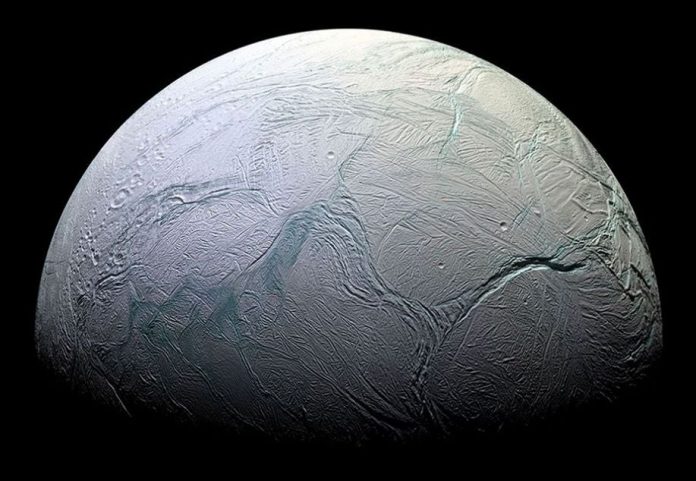
If you’ve ever dreamed of exploring space, you know there’ll be some serious dangers. One of them is posed by cosmic rays.
These high-speed particles slam through anything, including our bodies, damaging DNA and ripping molecules apart.
As dangerous as they sound to unprotected spacefarers, they could actually help microscopic life survive hiding under the icy surfaces of places like Europa or Enceladus.
A team of researchers led by Dimitra Atri at New York University’s campus in Abu Dhabi looked at the process of radiolysis, which occurs when cosmic rays slam into water or ice.
The high-speed particles break water molecules apart, which releases electrons, and some bacteria on Earth use those for energy. Could the same thing happen to possible life forms on icy worlds of the outer Solar System?
That’s what Atri’s team wanted to know.
Energetic radiation such as cosmic rays (and gamma rays) can reach the surface of terrestrial planets with thin atmospheres (think: Mars). It also has enough energy to ionize atoms and molecules on those worlds.
That provides an energy source for forms of microbial life that can withstand high radiation levels. Some of them even thrive in such environments. So, it’s not a stretch to look at cosmic rays as a source of energy for such life on other worlds.
The power of high-speed particles
Cosmic rays deliver a powerful radiation punch. Most are made of hydrogen nuclei, although a smaller amount are helium or other elements.
They come from several sources in the Universe. The Sun emits them, as do supernova explosions, clusters of massive, energetic stars, and even the busy regions around black holes. They travel at close to the speed of light and scientists are still studying all the ways they are energized.
When they come into contact with Earth’s atmosphere, cosmic rays are usually blocked by our atmosphere. Occasionally some get through, and will strike atmospheric particles to create secondary showers of other particles that do reach the surface.
High-speed particles such as cosmic rays play important roles in the Universe, from the generation of elements in interstellar space to activity that may have spurred the creation of life on Earth.
Here at home, we often blame “cosmic rays” for computer glitches and other mishaps. Largely they pass right through us, but usually don’t cause damage.
However, if we go out into space or enter very high altitudes (riding in a jet aircraft, for example), we’re faced with a larger number of them. Exploring near-Earth space, the Moon and beyond exposes us to very dangerous amounts of such cosmic radiation. Out there, astronauts have to shield themselves to avoid damage. It’s not just in space or on the Moon, either. Exploring Mars will expose people to a constant, life-long rain of cosmic rays, since the atmosphere is so thin and doesn’t provide a good shield.
Cosmic Rays and Icy Worlds
The Abu Dhabi team used computer simulations of cosmic ray strikes on icy worlds. The idea was to see how much energy radiolysis would produce on planets like Mars and the icy moons of Jupiter and Saturn. It turns out that Enceladus is a pretty good candidate for cosmic ray strikes on ice to produce enough energy to fuel possible life forms under its frozen surface. Mars could also be a potential life habitat benefitting from cosmic ray flux, as well as Europa.
The simulations inspired the idea of a “Radiolytic Habitable Zone” on those worlds. This would be a place in a planetary system where underground water (in the liquid or frozen form) could be energized by cosmic rays to produce energy for potential life. If this type of habitable zone could exist, that means there’d be a lot more places in the Universe where life could spring up, thanks to cosmic rays, according to Atri.
“This discovery changes the way we think about where life might exist,” said Atri. “Instead of looking only for warm planets with sunlight, we can now consider places that are cold and dark, as long as they have some water beneath the surface and are exposed to cosmic rays. Life might be able to survive in more places than we ever imagined.”
Life in More Places
Think about it. If cosmic radiation from these particles can spur the formation (or evolution) of life, then it widens the scope of the search for life by astrobiologists. Many icy worlds exist, even in our own Solar System. Astrobiology searches now focus largely on surfaces where life might be possible. They also look largely at so-called “habitable zones” where planets have liquid water on their surfaces.
Since cosmic rays can penetrate several meters beneath the surface of a world, that opens up a huge new range of habitats for life. Also, in the case of Europa, it means that this world – which is embedded in a high-radiation environment around Jupiter – could also be capable of harboring and sustaining life thanks to cosmic rays. The same would be true of Enceladus at Saturn.
On Mars, conditions are pretty inhospitable to surface life thanks to increased UV radiation, a very dry climate and extremely low temperatures. However, cosmic rays striking icy subsurface layers could stimulate other cycles there to provide a somewhat welcoming habitat for such life forms as halophiles (salt-loving microbes) that could exist in such an environment.
The team’s research provides a pathway in the search for life on distant worlds. This includes some where scientists might not have thought to look before now. That includes the subsurface regions of icy worlds – some of the darkest, coldest places in our own Solar System and beyond.
Written by Carolyn Collins Petersen/Universe Today.



